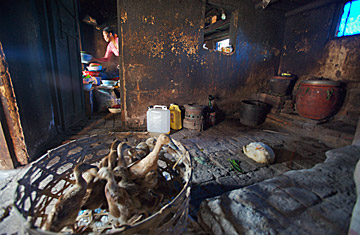
CLOSE QUARTERS: Fowl are kept in the kitchen of a family home in the Balinese village of Munduk Juwet as they await sacrifice in a Hindu ceremony marking six months of an infant's life
(3 of 3)
One front in the war on bird flu is the FAO and MOA's participatory disease surveillance and response (PDS/R) program. The brainchild of Roeder, Jost and Jeff Mariner, also of the ILRI, the program is epidemiology from the ground up. Instead of passively waiting to hear about H5N1 outbreaks in poultry, government vets like Hidayat fan out to the Indonesian countryside, where they educate and enlist villagers in the fight against bird flu, effectively extending the country's thinly stretched defenses. Begun in the fall of 2005 as a pilot project chiefly funded by USAID, PDS/R has grown to over 160 districts throughout the country, with some 1,300 Indonesian veterinary officials working part-time for the program in the field. "When we began we had no idea how much [bird-flu] infection was in Indonesia," says Roeder. "This finally told us how much disease is out there."
Still, the gap between intentions and actions is obvious at a meeting in a stuffy office in Serang district, west of Jakarta, where a group of vets lay their complaints out to Eric Brum, an FAO officer. First, they'd like some new motorcycles—always their first priority, Brum notes with a laugh. But as they take turns speaking, it becomes clear their impatience with the government is real. A vet named Suryono explains the tortured process vets need to follow to procure compensation for culled birds. "We get the farmers to give us a list of their poultry," he says. "Then we assess the price. Then they sign it. And then we bring this document to the MOA in Jakarta. And then we wait for the money to come. And then we bring the cash to the village." By that time, the point of giving compensation at all—encouraging farmers to cooperate with vets—is already lost.
The failure to provide compensation efficiently is emblematic of Jakarta's generally half-hearted response to bird flu, despite bright spots like the PDS/R project. But put that criticism to a central government official, and they'll usually respond as Bayu Krisnamurthi does. "We are faced with poverty, with tsunamis, with earthquakes," says Krisnamurthi, the chief executive of Jakarta's national bird-flu task force. "We have our idealism and our vision, but we also have our challenges and our difficulties." He also has a point. During my trip Jakarta endured a severe outbreak of dengue fever, and on the day I traveled to Kemuning village with the bird-flu team there were over 100 new cases of dengue in the capital. "Avian flu is a threat, but we have many more," says Dr. Sadikin Giriputro, director of Sulianti Saroso hospital, Jakarta's main bird-flu center.
It's a tempting argument, and one that's easier to accept every day the predicted pandemic fails to appear. But Dr. Nur Rasyid Lubis knows better. The deputy director of Adam Malik hospital in the city of Medan in North Sumatra, last May Lubis treated what became the largest single human bird-flu cluster—eight family members from the nearby village of Kubu Sembilang, seven of whom would die in Lubis' hospital. From the start human-to-human transmission seemed like the only explanation for the size of the cluster, which triggered international panic. Though in the end the virus didn't pass beyond the family, the Kubu Sembilang cluster may be the closest we have yet come to a pandemic. It was enough to rattle Lubis, who found half his staff initially too scared to work. "We were really very worried," he says. "I can't even imagine what would have happened if it had been a pandemic. We weren't ready at all."
As long as Indonesia's poultry remains engulfed in bird flu, and chickens remain such an integral part of Indonesian village life, human cases will continue to occur (there have been 24 this year alone). Every time they do, the H5N1 virus will get another chance to click on the genetic combination that can trigger a pandemic. The country's failings on animal health—however excusable, however seemingly insignificant compared to its semi-constant catastrophes—could blow back at any time. Another Kubu Sembilang could be waiting to happen, and this time we might not be lucky. After meeting with Lubis, I took a bumpy drive to the village, where I hoped to speak to the one remaining member of the North Sumatra cluster. But when I arrive, the survivor is nowhere to be found, and doors are shut tight against outsiders curious about bird flu. The only one who will speak to me is Pasu Sembring, the deputy village chief. He says they had never heard about bird flu before the cluster, and that many still doubted the flu existed. I ask if he can remember any bird deaths before the cases. He considers for a moment, and then shrugs. "Sure, every year, but it's not very serious," Pasu says. "It's just chickens."